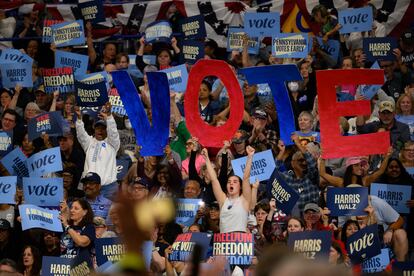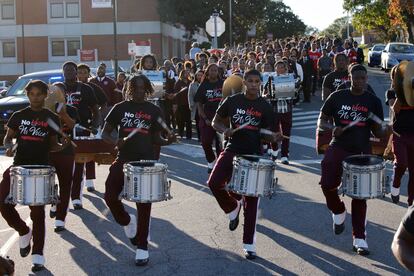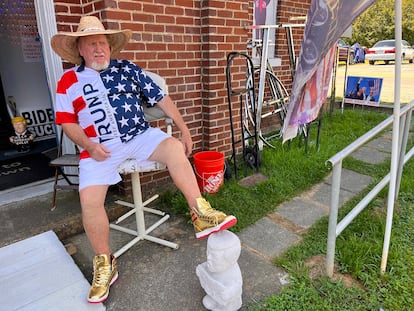‘Fascist!’ ‘Enemy within!’: Polarization intensifies in final stretch of US election
The campaign has reached a degree of tension between Republicans and Democrats that was unthinkable before Trump burst onto the political scene


The senator and highly decorated war veteran John McCain, the Republican presidential candidate for the 2008 election, once stopped one of his supporters in her tracks during a campaign event. The voter was declaring her suspicions about the Democratic candidate, Barack Obama: “I have read about him and he’s not, he’s not uh — he’s an Arab.” McCain snatched the microphone from her: “No, ma’am. He’s a decent family man [and] citizen that I just happen to have disagreements with on fundamental issues and that’s what this campaign’s all about. He’s not [an Arab].” But those were different times in American politics.
In Butler, Pennsylvania, a Democratic voter complained that after putting a bumper sticker in support of Kamala Harris on her car, someone threw a brick at her. In Fairfax, Virginia, a Republican complained that he had placed a yard sign supporting his candidate, Donald Trump, 40 times, only to have it stolen on all 40 occasions. In Quemado, Texas, a New Yorker who supports Trump says she moved to that state, among other reasons, because she couldn’t stand “being surrounded by Democrats.”
That the United States is today a highly polarized country is evident, to the point that the descriptor has become commonplace in any conversation about the November 5 election. That gesture by McCain seems like something very far removed in time, almost the stuff of legend.
As November 5 approaches, the campaign between the Republican Trump and the Democrat Harris has been hardening in tone — driven, above all, by the former president — to levels that would have been unthinkable in American high politics before the real estate magnate burst onto the political scene. A week ago, the former president called Democratic supporters “the enemy from within” and raised the possibility of using the National Guard against them, simply for disagreeing with him.
“He considers anyone who doesn’t support him or who will not bend to his will an enemy of our country,” Harris said at a rally in Erie, Pennsylvania. “He says he will use the military to go after them.” In the past week, the vice president has also intensified her verbal attacks against her rival. She has echoed the words of the former chief of staff in the Republican’s first term, General Mark A. Milley — who then continued for a few years under Joe Biden — to declare that the former president “is fascist to the core.” “Why can’t we just say it?” the radio host Charlamagne Tha God asked her in a recent interview. Harris’s response was clear: “Yes, we can say it.” Until now, the use of the word “fascist” was taboo among Democratic politicians.
Divisions have always existed in the history of the United States, as in any other country. They even once led to a civil war between 1861 and 1865. But these divisions had not been so marked since the 1960s and the era of the struggle for civil rights and the Vietnam War.
The phenomenon was exacerbated by the rise of populist radio and television networks during the administrations of Bill Clinton (1993-2001) and George W. Bush (2001-2009); it continued under Barack Obama (2009-2017) and reached “pernicious” levels starting in 2015, with the launch of the campaign that would bring Trump to the presidency, turning the U.S. into the most polarized of all Western democracies. Its political polarization levels double the global average, according to a study by Jennifer McCoy, from the University of Georgia, and Murat Somer, from Koç University in Istanbul. “The United States stands out today as the only wealthy Western democracy with persistent levels of pernicious polarization,” the authors write.
Ideological polarization is at its peak within the parties. In Congress, in vote after vote, lawmakers stand with the position of their group with hardly any deviation. It has become a rarity for a measure to be passed with the majority support of both Democrats and Republicans. Torpedoing the proposals of the other party is the norm. There is no consensus of opinion, at least outwardly. Certainly, there is less consensus in areas in which both parties had historically collaborated more, such as foreign policy.
This carries geopolitical risks, as Jordan Tama of American University warned at a recent seminar organized by the think tank Chatham House. “The more polarization there is, the more incentive there is for other countries to interfere in U.S. elections: if there is a lot of distance between Democrats and Republicans, another country, whether it is Russia, China or Iran, has more potential to gain by influencing the outcome of an election.”

Among citizens, the divide is more emotional than ideological, said Rachel Kleinfield of the Carnegie Endowment for International Peace at the same event. Citizens, she explained, agree more than they might seem to on issues such as abortion or immigration; the difference lies instead in the importance they assign to each one: gun control, for example, is fundamental for Democrats but much less relevant for Republicans.
“They look at the positions of their leaders, of these very ideologically polarized people, and from that they deduce that their followers also support those positions. They reason: ‘If you vote for this person, you must think like them,’ and they assume tremendously mistaken perceptions about the average voter of the other party,” Kleinfield explained. “This leads to a very high level of emotional polarization, which grows rapidly. People from different parties do not want to interact or live near each other, and they do not want their children to marry those of the other party.”
States that are increasingly blue or increasingly red
The result is a country where political differences spill over into the zip code. Democratic states are increasingly “blue” and Republicans are increasingly “red.” In 23 of the 50 states, Republicans control all levels of government: the governor, the local legislature and the attorney general’s office. In another 19, Democrats maintain the same position of total power. In 1996, only seven states decided their winner by more than 20 percentage points. In 2020, it was 19. And in 2024, the vote is only considered truly close in seven states: Pennsylvania, Michigan, Wisconsin, Arizona, Nevada, Georgia and North Carolina. In the rest, with two weeks to go to the election, the outcome already seems a given.
A study from the Annenberg School at the University of Pennsylvania, led by Neil Fasching, finds that political animosity toward the other party persists among citizens even after elections. “Citizens no longer recover from campaigns and elections; instead, they maintain their high levels of affective polarization—the tendency for political party members to harbor distrust and aversion toward members of the opposing party—and do not walk back their support for violations of basic democratic norms or the use of political violence (although overall levels of support for political violence remain low),” the authors write.
The gap is also becoming increasingly accentuated by the education factor. In 2006, there was no difference between Republican or Democratic voters based on their level of education. In 2020, Joe Biden won the vote of 54% of those with a college degree, and only 37% of those without higher education. A trend that, according to polls, is set to repeat itself this year: working-class voters generally lean towards Trump; those with higher education, towards Kamala Harris.
This factor helps explain another phenomenon: the shift in allegiance among African-American and Latino voters, a segment of the population where college graduates are less common. In the past, these groups had largely supported Democrats. But a significant percentage, especially among men, now declare themselves supporters of Trump.
The undecided voter, a rare bird
Polarization, which firmly places voters on one side or the other, means that fewer and fewer voters are undecided or likely to change their vote from one election to the next, or depending on whether it is a vote for the presidency, Congress or local government. At the start of the campaign, each party already has 40% of the votes guaranteed and 40% that it will not get under any circumstances. The fight is, in the best of cases, for the remaining 20%. If it’s even that much.

The division is a dynamic that is fed by the parties themselves, which are also polarized. In a two-party electoral system, where candidates are decided in primary elections and in which the winner in each State takes all the electoral college votes, polarizing the public helps you win elections, explains Kleinfield. On the one hand, it facilitates fundraising, something fundamental in the American system. “Appealing to emotions helps, especially if you are looking to have many small donors, and that is the tendency in the parties. Small donors contribute out of anger and emotion,” she points out. On the other hand, in the primary process — in which the name of the candidate is decided — those who go to vote are usually the most convinced supporters and those with the most extreme positions in each party.
“What used to happen was that candidates would take extreme positions in the primaries and then moderate them in the general elections,” notes the Carnegie Endowment expert. “But now that states are so tilted towards one party or the other, in local elections the opposition often doesn’t even bother to nominate a candidate. So there’s no need to moderate those positions: if you win the primaries, you’ve won. And those extremist candidates are the ones who later become lawmakers.”
Once in Congress, these politicians' extreme statements and proposals help them receive media coverage. And with it, donations from their supporters, which in turn allow them to continue winning elections. According to Dartmouth College's Polarization Research Lab (New Hampshire), the most incendiary rhetoric on Capitol Hill consistently comes from a very small number of lawmakers.
All these factors have aggravated polarization to the point that the NGO Freedom House, which studies the state of democracy and freedom in the world, considers that freedom in the United States has been deteriorating over the last 11 years. It receives 83 points out of 100; the same as Croatia, Romania or Panama, and less than Spain and Italy (90) or Costa Rica (91).
The North Carolina example
In western North Carolina, even federal relief efforts after Hurricane Helene’s catastrophic impact three weeks ago have become a divisive issue. In the heavily Republican rural areas that were affected, rumors led some of the victims to reject the aid to which they are entitled, and to complain that the government is doing less than it could.
“I personally haven’t received anything,” said Carin, whose coffee shop in the town of Chimney Rock was washed away. “Some officials have been here and helped, but all of this stuff here is privately sourced,” she said at a relief distribution point near tourist-friendly Lake Lure. “We haven’t had any supplies from federal agencies.”
Fifty miles away, in the progressive enclave of Asheville, several houses, still bearing the signs of disaster in the fallen trees and bags of debris on the sidewalk, display large, handmade signs reading: “Thank you, rescuers!”
“It’s not true that federal agencies are not helping or are dragging their feet,” says Katie, who works in a tourist souvenir shop. “From the beginning, they have done nothing but help. Ask anyone here and they will tell you that these teams arrived as soon as possible and got to work immediately. There may be instances where it took longer, but they are doing everything they can and more.”
Authoritarianism and political violence
A study by the Democracy Fund points to a risk in this situation: the growth of authoritarianism. A survey of the same group of Republican voters over the years found that when the person in power is “one of their own,” they are 22% more permissive with him. In the case of Democrats, dogmatism is less political — these voters are only 6% more inclined to remove restrictions from their ruler — and more cultural.
Another risk could be the rise of political violence, a fear that is growing after Trump suffered two assassination attempts in the past four months. Kleinfield clarifies that, in both cases, the perpetrators did not seem to have a clear political motive. However, “a general atmosphere of polarization that normalizes violence in a highly armed society like ours makes impulsive, aggressive people think that they will be valued for doing that, or they will get fame, or glamour. And that makes it more likely to happen.”
Meanwhile, citizens mired in polarization want to see an end to these differences. The deeply divided Congress receives a very low rating among voters: only 21.7% approve of it, while 62.9% criticize it, according to the polling aggregator of electoral analyst Nate Silver.
In an extremely polarized campaign, there has been a ray of hope: the debate between the vice presidential candidates, J.D. Vance and Tim Walz, played out in terms of exquisite civility between the opponents. Unusually, they even chatted pleasantly with their wives after their sparring. Neither of them said anything like McCain did in 2008, but in such a divisive climate, a handshake and a cordial smile also seem like something from another era.
Sign up for our weekly newsletter to get more English-language news coverage from EL PAÍS USA Edition
Tu suscripción se está usando en otro dispositivo
¿Quieres añadir otro usuario a tu suscripción?
Si continúas leyendo en este dispositivo, no se podrá leer en el otro.
FlechaTu suscripción se está usando en otro dispositivo y solo puedes acceder a EL PAÍS desde un dispositivo a la vez.
Si quieres compartir tu cuenta, cambia tu suscripción a la modalidad Premium, así podrás añadir otro usuario. Cada uno accederá con su propia cuenta de email, lo que os permitirá personalizar vuestra experiencia en EL PAÍS.
¿Tienes una suscripción de empresa? Accede aquí para contratar más cuentas.
En el caso de no saber quién está usando tu cuenta, te recomendamos cambiar tu contraseña aquí.
Si decides continuar compartiendo tu cuenta, este mensaje se mostrará en tu dispositivo y en el de la otra persona que está usando tu cuenta de forma indefinida, afectando a tu experiencia de lectura. Puedes consultar aquí los términos y condiciones de la suscripción digital.
More information
Archived In
Últimas noticias
NASA discovers Titan doesn’t have an ocean, but a ‘slushy ice layer’ that increases possibility of life
Innocence lost in the forest of the child soldiers: ‘Each leader of the armed group had his girls’
‘Fallout’ or how the world’s largest company turned an anti-capitalist apocalyptic Western into a phenomenon
From inflation to defending migrants: Eileen Higgins and Zohran Mamdani inaugurate the new Democratic resistance against Trump
Most viewed
- ‘El Limones’ and the growing union disguise of Mexican organized crime
- Christian Louboutin: ‘Young people don’t want to be like their parents. And if their parents wear sneakers, they’re going to look for something else’
- The low-cost creative revolution: How technology is making art accessible to everyone
- ‘We are dying’: Cuba sinks into a health crisis amid medicine shortages and misdiagnosis
- Liset Menéndez de la Prida, neuroscientist: ‘It’s not normal to constantly seek pleasure; it’s important to be bored, to be calm’










































